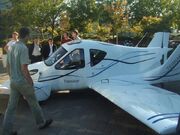
Airless tire - tires that are not supported by air pressure.
Artificial Passenger - a telematic device, developed by IBM, that interacts verbally with a driver to reduce the likelihood of them falling asleep at the controls of a vehicle.[1] The Artificial Passenger is equipped to engage a vehicle operator by carrying on conversations, playing verbal games, controlling the vehicle's stereo system, and so on. It also monitors the driver's speech patterns to detect fatigue, and in response can suggest that the driver take a break or get some sleep.[3][4] The Artificial Passenger may also be integrated with wireless services to provide weather and road information, driving directions, and other such notifications systems.

Oceanvolt SD8.6 electric saildrive motor
includes Electric vehicle, Hydrogen vehicle, Compressed air vehicle.
Driverless car - an autonomous vehicle capable of fulfilling the human

Google driverless car
transportation capabilities of a traditional car. As an autonomous vehicle, it is capable of sensing its environment and navigating without human input. Robotic cars exist mainly as prototypes and demonstration systems, but are likely to become more widespread in the near future.
Flying car - a hypothetical personal aircraft that provides door-to-door aerial transportation. Examples of such cars:Terrafugia Transition, Moller M400 Skycar, Urban Aeronautics X-Hawk.

Terrafugia Transition flying car
See a TED presentation.

A maglev train in China
a vehicle is levitated a short distance away from a guide way using magnets to create both lift and thrust. Most significant developments: in China.
Vactrain - a maglev line run through evacuated (air-less) or partly evacuated tubes or tunnels. The lack of air resistance could permit vactrains to use little power and to move at extremely high speeds, up to 4000–5000 mph (6400–8000 km/h, 2 km/s), or 5–6 times the speed of sound (Mach 1) at standard conditions.[1] Though the technology is currently being investigated for development of regional networks, advocates have suggested establishing vactrains for transcontinental routes to form a global network.
Hyperloop - "an

Hyperloop infrastructure
elevated, reduced-pressure tube that contains pressurized capsules driven within the tube by a number of linear electric motors." A designed has been proposed for California in 2013
More here